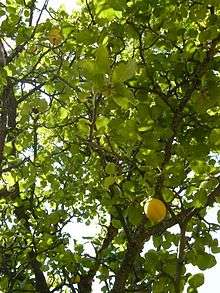Prunus ursina
| Bear's plum | |
|---|---|
 | |
| Prunus ursina in Horsh Ehden reserve, Lebanon | |
| Scientific classification | |
| Kingdom: | Plantae |
| (unranked): | Angiosperms |
| (unranked): | Eudicots |
| (unranked): | Rosids |
| Order: | Rosales |
| Family: | Rosaceae |
| Subfamily: | Amygdaloideae |
| Genus: | Prunus |
| Species: | P. ursina |
| Binomial name | |
| Prunus ursina Kotschy[1] | |
Prunus ursina (bear's plum, خوخ الدب ) is a species of prunus native to the woods of Western Asia from Turkey to Syria and Lebanon.[1]
Etymology
Prunus, from the Latin "prūnus" which is a loan from Greek (προῦνον, prounon) means plum tree. Ursina derives from "ursus", a bear, referring to one of a bear's favorite foods.[2]
Description
Prunus ursina is a deciduous shrub to a small tree, reaching 4 to 8 meters in height; it is highly branched and the branches sometimes bear spines. The twigs are velvety and the leaves are ovate to oblong. Prunus ursina produces white hermaphrodite flowers in pairs during the spring. Its 2-to-3cm unpalatable fruit is globose and turns yellow to dark orange when ripe but may be toxic if consumed excessively.[1][3]
Synonyms
- Prunus divaricata ursina[3]
Uses
The fuit can be used to obtain a dark grey to green dye and a green dye can be obtained from the leaves.[4]
Plants in the Prunus species contain amygdalin and prunasin, substances which break down in water to produce hydrogen cyanide. Hydrogen cyanide is a colorless, extremely poisonous chemical that gives almonds their characteristic flavour. These substances are found mainly in the leaves and seed and can be detected by the bitter taste. It is usually present in too small a quantity to do any harm but any very bitter seed or fruit should not be eaten.[3]
Consumption of small quantities of hydrogen cyanide stimulates respiration and improves digestion. Excessive consumption of the toxin can cause respiratory failure and death.[3]
Cultivation
Prunus ursina fuits better in full sun but is still successful in partial shade. The tree will form suckers if its shallow roots are damaged. Among the pests that affect the prunus genus is honey fungus.[5] the seed requires 2-3 months cold stratification in order to germinate.[3]
References
- 1 2 3 "Prunus ursina Kotschy". Lebanon-flora.org. Faculty of Sciences, Université Saint-Joseph de Beyrouth. Retrieved 3 September 2013.
- ↑ Modzelevich, Martha. "Prunus ursina, Bear's Plum, שזיף הדב". Flowers in Israel. flowersinisrael.com. Retrieved 3 September 2013.
- 1 2 3 4 5 "Prunus ursina — Kotsch.". Plants For A Future. Retrieved 3 September 2013.
- ↑ Ida Grae (February 1979). Nature's colors: dyes from plants. Collier Books. ISBN 978-0-02-012390-3. Retrieved 3 September 2013.
- ↑ Royal Horticultural Society (Great Britain) (1992). The New Royal Horticultural Society Dictionary of Gardening. Macmillan Press. ISBN 978-1-56159-001-8. Retrieved 3 September 2013.